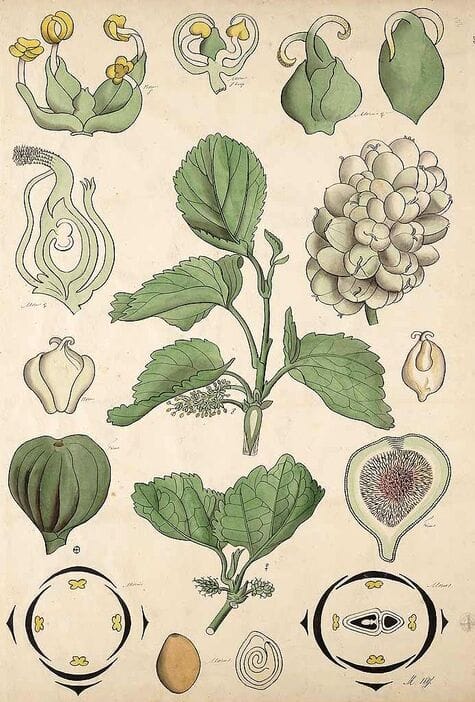Morus Cortex, Mulberry Bark, Sang Bai Pi 桑白皮
Sang Bai Pi (TCM) Botanische wandplaten (Plantillustrations)
Botanische wandplaten (Plantillustrations)Botanical name:
Morus alba
Parts used:
Root-Bark
Temperature & Taste:
Cold, dry. Sweet. Some older TCM sources said it was Warm, others said Neutral
Classifications:
Q. Stop Cough and Wheezing
Uses:
1. Clears Lung Heat, Stop Cough and Wheezing:
-Cough and Wheezing from Lung Heat
2. Promotes Urine:
-Edema from heat obstruction (especially puffy eyes, facial edema, edema of extremities)
-it has a marked diuretic effect
3. Settles Wind:
-Hypertension, Palpitation
-Infantile Convulsions, Epilepsy
-antihypertensive effect has been shown
4. Benefits Qi:
–“good for tonifying … It treats diseases caused by five overstrains and six extremes” (Shen Nong Ben Cao)
-“tonifies a condition of interior insufficiency” (Zhen Quan)
-“benefits all the Five Viscera” (Meng Xian)
-“tonifies the insufficient condition of Yuan Qi (Primordial Qi)”. (Li Gao)
5. Kills Worms:
-“Kills Tapeworm” (Mingyi Bielu)
-“Kills worms in the Viscera and Bowels” (Da Ming)
Dose:
Root-Bark in Decoction (TCM): 6–15 grams
Powder: 2–5 grams
Comment:
This is used similarly to Mulberry bark in the West which is also used for Edema.
Preparation:
1. Honey-Fried Mulberry bark (Zhi Sang Bai Pi):
The bark is mixed with honey and water, left to soak briefly, then stir-fried to yellowish and the honey is no longer sticky. This lessens its cold and dry nature, moistens and nourishes the Lungs, and is better for wheezing. This will also enhance the Qi tonic properties which old TCM texts
Main Combinations:
1. Lung Heat Cough, Bronchitis, Wheezing:
i. Morus Sang Bai Pi with Lycium Di Gu Pi, Licorice
ii. Morus Sang Bai Pi with Fritillaria Bei Mu, Platycodon Jie Geng
iii. Morus Sang Bai Pi with Scutellaria Huang Qin, Almond/Apricot kernel (Xing Ren),
iv. Ephedra Ma Huang, Morus Sang Bai Pi (Mulberry root-bark), Licorice, Platycodon Jie Geng (as in Zhen Ke Ning Tang Jiang of the Chinese Pharmacopoeia)
v. from Phlegm-Heat, Morus Sang Bai Pi with Pumice (Fu Hai Shi), Cynanchum Bai Qian
vi. with hard-to-clear Phlegm, Morus Sang Bai Pi with Loquat leaf (Pi Pa Ye), Platycodon Jie Geng, Stemona Bai Bu
vii. Cough and Wheezing with copious yellow Phlegm, Morus Sang Bai Pi with Ginkgo seed (Bai Guo), Ephedra Ma Huang, Apricot/Almond kernel (Xing Ren)
viii. Chronic Cough, Morus Sang Bai Pi with Aster Zi Wan, Asparagus Tian Men Dong, Licorice
2. Asthma from Heat, Morus Sang Bai Pi with Ephedra Ma Huang, Almond/Apricot kernel (Xing Ren), Scutellaria Huang Qin
3. Edema:
i. Morus Sang Bai Pi with Cinnamon (Rou Gui), Atractylodes Bai Zhu, Poria Fu Ling
ii. Morus Sang Bai Pi with Ephedra Ma Huang, Poria Fu Ling, Atractylodes Bai Zhu
iii. Morus Sang Bai Pi with Liquidamber Lu Lu Tong, Poria peel Fu Ling Pi
iv. Facial Edema, Puffy eyes, Morus Sang Bai Pi with Lepidium Ting Li Zi
4. Hypertension:
i. Morus Sang Bai Pi with Self Heal (Xia Ku Cao), Cassia tora Jue Ming Zi
ii. Morus Sang Bai Pi with Scutellaria Huang Qin, Mistletoe (Sang Ji Sheng), Self Heal (Xia Ku Cao),
5. Leukemia, decoct roots of Willow, Pear, Peach and Mulberry (Anti-Cancer Medicinal Herbs, Chang Minyi, 1992)
6. Esophageal Cancer, decoct Morus Sang Bai Pi (30 grams) in 90 mls Vinegar for 1 hour, sugar may be added. The decoction is taken in one dose. It was found to give good symptomatic relief.
Major Formulas:
Xie Bai San
Ding Chuan Tang
Bu Fei Tang
Qing Fei Tang
Ren Shen Bu Fei Tang
Ren Shen Ge Jie Tang
Wu Pi San
Jiu Xian San
Cautions:
Not used in Cold-type Cough
Toxicity:
LD50 of water or alcohol extract orally in mice is 10g/kg.
